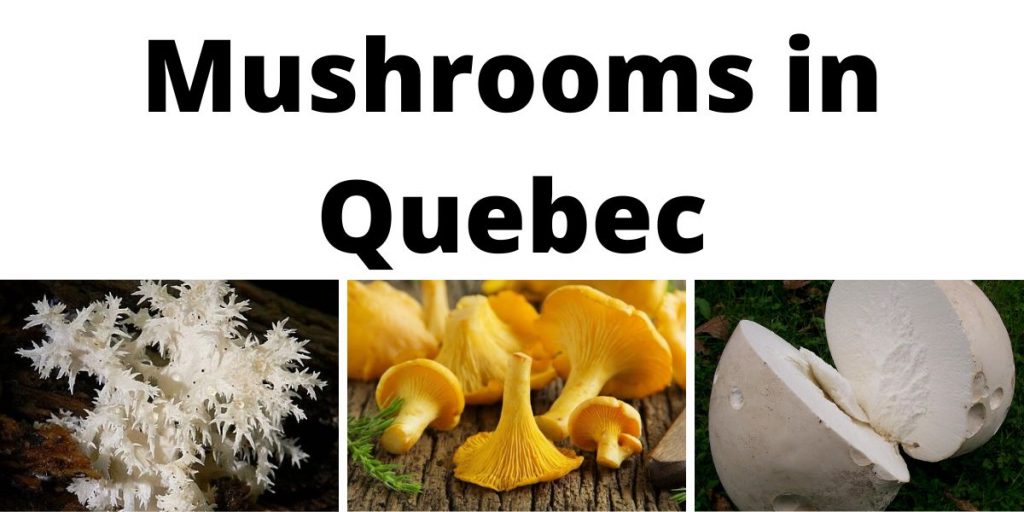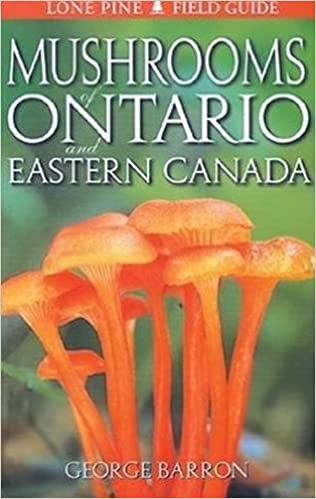Quebec stretches across a very large area—it is bigger than all of France—but has very few people in it, most of them clustered in the south and southeast of the province. Much of the land is forested, most of that protected. Throughout those forests, as well as in yards, gardens, and roadside verges, grow mushrooms, although there may be a greater variety clustered in the warmer, southern areas. As usual, we can’t tell you about all of them, there are way too many, but we can introduce you to some of the more interesting species[i][ii][iii].
If you do indeed go Mushroom Hunting make sure you have the proper tools, take a quality knife with you and a basket/bag for your haul!
Mushroom foraging is becoming more and more popular, a development we obviously encourage. This list is not meant to be used as a replacement for a field guide, spore prints, an identification app or an in person guide. We do not encourage beginners to use articles like this one as a guide. Becoming a competent forager takes a lot of careful study, and there are no shortcuts up the top of the learning curve. “Foolproof” species usually aren’t, and complications abound.
The following list is just to encourage you to keep working at it until you get there.
Our Recommended Field Guides
COVER | TITLE | Header | ||
|---|---|---|---|---|
OUR #1 RATED | ||||
Edible Mushrooms
Chanterelles
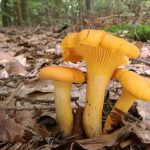

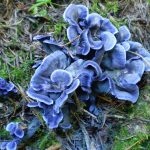

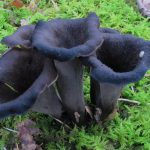

The Chanterelles are a group of closely-related mushrooms known for having ridges instead of gills. Most are delicious, and while there are inedible ridged mushrooms, they are atypical members of the group and fairly easy to differentiate. Most chants—and arguably all the true chants, belong to the genus, Cantharellus, but there are several related genera whose members are quite similar, also edible, and sometimes called Chanterelles. Quebec has at least three members of the group.
The Golden Chanterelle was once considered a single species, and still sometimes referred to by the old scientific name. Actually, it is a complex of very similar species in the Cantharellus genus, all of them yellow and somewhat variable in shape and size. All of them, like other members of the genus, to varying degrees, are known for a lovely, fruity aroma, and are prized by chefs. We have not been able to track down confirmation of which of these Quebec actually has.
The Blue Chanterelle (Polyozellus multiplex)[iv] grows in clusters, almost like some of the polypores, and has a succulent texture and a smokey aroma capable of flavoring entire dishes. These mushrooms will also stain anything they touch blue. Be forewarned.
The Black Trumpet or Black Chanterelle (Craterellus fallax) also can stain things it touches, at times. It is much thinner and drier in texture, almost papery, though its aroma is fruity, more like that of the Cantharellus chants. Its spore-production surface is smooth, or nearly so, not ridged. Its dark color makes it very difficult for foragers to find.
Two other species deserve mention in this section. The Hedgehog (Hydnum repandum) mushroom does not closely resemble the chanterelles—it has short spines, rather than gills or ridges—but is related to them and can be used the same way in recipes. The Scaly Hedgehog or Hawk’s Wing (Sarcodon imbricatus) shares the spiny structure and is a close look-alike of the hedgehog, but it is hit-or-miss in flavor.
Ink Caps
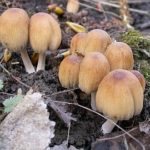

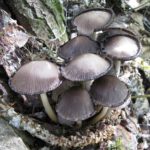

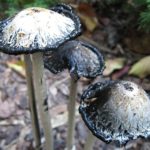

Ink caps are no longer considered related to each other, but they all share an interesting characteristic; at maturity, they turn into black goo and drip away. The spores disperse via the runny liquid, not by wind as many other fungal spores do. Many people assume that the goo is inedible, but it actually can be used in cooking and makes an interesting food dye. Not surprisingly, though, it is the solid, fleshy, not-yet-gooey mushroom most people like. They are tricky to cook with, as picking the mushroom will speed up gooification—shelf-life before goo is measured in hours.
Some ink caps are often listed among the poisonous mushrooms because they interfere with the metabolism of alcohol. Eat these mushrooms and then have a drink the same week, and you will get sick. However, going a week without alcohol is not difficult for most people, and these mushrooms are otherwise harmless. Quebec has at least two in this group, the Mica Cap (Coprinellus micaceus) and the Common Ink Cap (Coprinopsis atramentaria) The Shaggy Mane (Coprinus comatus) is another inky in the province, but it seldom if ever interferes with alcohol.
Hericiums
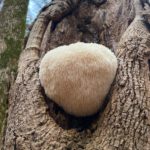



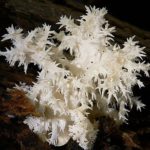

The Hericiums are a small genus notable for being covered all over by soft, hairlike spines. Unlike the Hedgehog Mushrooms, they don’t have a stem-and-cap structure. The Lion’s Mane (H. erinaceus) looks rather like a pom-pom, a single club-like structure covered with fur. Bear’s head (H. americanum) branches and has much longer spines, while Coral Tooth (H. coralloides) (not to be confused with the utterly unrelated group, the Coral Fungi) also branches but has very short spines. All three are white or whitish and fruit from dead or dying wood. All three taste very much like crab meat, and the hairlike spines do not have a noticeable texture in the mouth.
Lion’s Mane is the best-known of the group and some preliminary research suggests it may have medicinal value. Many writers go ahead and ascribe the same medicinal value to the entire genus and treat the Hericiums as interchangeable, but there is as yet no evidence for that.
Puffballs
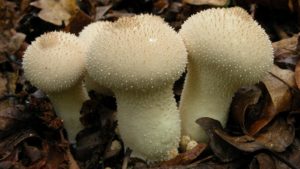

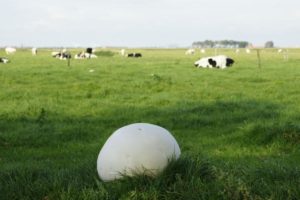

The Puffballs are a large group of mostly unrelated mushrooms that all have an entirely-enclosed, ball-like shape. The spores develop inside the ball and are only released when the ball ruptures or opens a pore at maturity. Some have short stalks, some do not. Some are edible prior to spore maturation, while the interior is still white. There are many writers who assert that all puffballs are safe to eat, but that is only because they are using the word, “puffball,” to refer only to the edible ones, designating the others as “false puffballs.” That seems unwarranted. But differentiating the edible from the inedible puffs is not difficult.
Quebec has at least two edible puffballs, the Common Puffball (Lycoperdon perlatum) and the Giant Puffball (Calvatia gigantea). The latter is aptly named, as it can reach basketball-size, or sometimes larger—a problem, as puffballs generally are so high in protein that they must be refrigerated immediately, just like meat. Basketballs don’t fit easily in refrigerators. The interior of both can be grilled, though the marshmallow-like texture is not everybody’s favorite, or it can be dried and powdered, then used in soups and breads.
A word of caution; always slice puffballs vertically before preparing them as food. Not only is it necessary to check the color of the inside to be sure the spores have not yet started to mature, but inspection of the interior is the only way to rule out several look-alikes, some of which have enough poison to kill.
Boletes
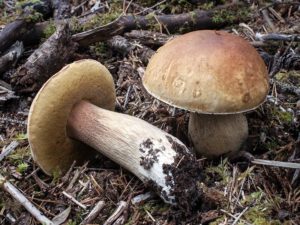

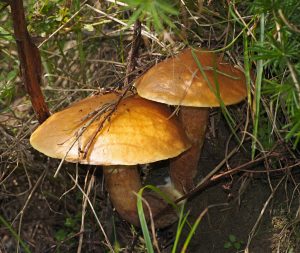

The Boletes are a large group of mushrooms that have the classic toadstool shape but have pores rather than gills under the caps. They are related to each other, but some are only distantly related, and the taxonomy of the group is particularly confused and subject to frequent revision. The common names are often more consistant than the scientific names, as they are less subject to change. Quebec’s complement includes the King Bolete and the Larch Bolete.
King Boletes are an added layer of taxonomic confusion, as there are multiple species, and it’s not always clear which is which. They are choice edibles and, perhaps as a result, have a huge number of common names (king, cep, pennybun, porcini). The Larch Bolete (Suillus grevillei) can fruit abundantly, but are mediocre in taste[v].
Fairy Ring Mushroom (Marasmius oreades)
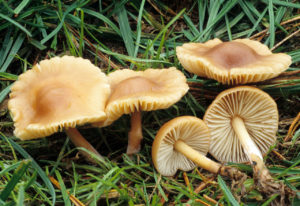

A fairy ring is a circle of mushrooms. It occurs when a fungus, growing underground, expands evenly in all directions but dies back in the center. Many plants and some lichens form rings in exactly the same way, but when fungi do it it’s especially dramatic because nobody knows the fungus is even there until it fruits—the spooky-looking ring of mushrooms pops up sometimes literally overnight. The term “fair ring” comes from the belief that the rings marked places where fairies either had danced or were actually still dancing invisibly. A mortal who got in the way might be grabbed and danced to exhaustion. It’s an intriguing story. But none of this will help you identify this mushroom species.
The problem is that lots of fungi fruit in rings, and this one doesn’t even do it all the time. But the name leads many inexperienced foragers to harvest all sorts of things, some of them poisonous, thinking they’ve got this once, just because of the ring-shaped fruiting pattern[vi]. The species needs a new common name. What about “brown sugar mushroom”? It is brownish, and the sugars in its tissues that allow it to rehydrate and resume spore production after dry periods also makes its flesh sweet[vii].
Indigo Milkcap (Lactarius indigo)
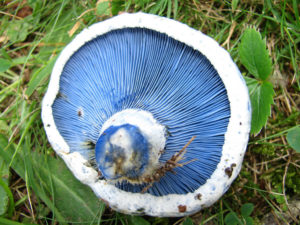

Milkcaps or milkys are notable for oozing runny latex when cut. The latex is usually referred to as milk, and in some species it is white, but in others it isn’t. In this species, it’s blue. In fact, the entire mushroom is blue. To an experienced forager, the unusual color and distinctive shape make this species unmistakable, though an inexperienced forager could easily get mixed up, as there are species, some of them poisonous, that are a different shade of blue or purple and have a vaguely similar shape.
In any case, the Indigo Milkcap[viii] is both edible and delicious, though prone to bug infestations. Foragers who find bug-free specimens have two options; they can either saute the mushrooms, which preserves their rich flavor but sacrifices some of the color, or they can cook them in water, which preserves the color but sacrifices some of the flavor. Tough choice.
Wood Blewit (Lepista nuda)
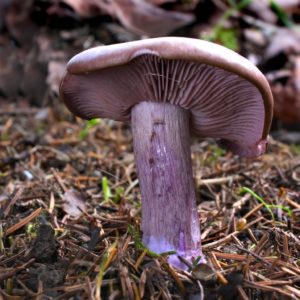

The Wood Blewit[ix] isn’t exactly blue. It’s more like purple, and it fades to mostly brown with age. It’s still a pretty mushroom, though, and good to eat, though it does have a number of possibly poisonous look-alikes. This species belongs to a large group of broadly similar but not necessarily related fungi badly in need of taxonomic sorting-out, so expect the genus name to change, one of these days[x].
Our Recommended Field Guides
COVER | TITLE | Header | ||
|---|---|---|---|---|
OUR #1 RATED | ||||
Poisonous Mushrooms
Mushrooms have a reputation for being scary—super-hard to identify and mostly poisonous. Actually, while mushroom identification is definitely a learned skill, you don’t have to get your PhD in mycology to do it. And most mushrooms aren’t poisonous. The problem is that newcomers to the field might not know which ones are difficult to identify and which ones aren’t, how much variation is normal within a species and how much isn’t, or how to notice the subtle details that make a big difference. The other issue is that there are lots of species that are only poisonous sometimes under some circumstances, requiring some careful judgment calls about what to risk eating and what to avoid. And no, there are no shortcuts, no simple rules of thumb. People who try following such rules get sick.
Here is a list of some of the species you very much want to not eat. Please remember that the list is not complete—there are poisonous species in Quebec that aren’t here.
Destroying Angel (Amanita bisporigera)
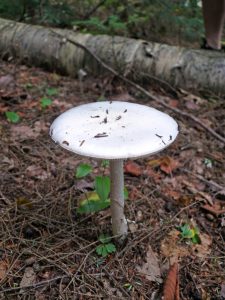

There are actually several destroying angel species across North America and Europe (sometimes the scientific name for the European species is mistakenly used for all of them). This is the one most likely to appear in Quebec, but all are large, handsome, white or whitish mushrooms with a distinct ring around the stem in maturity. Unfortunately, they are occasionally mistaken for any number of edible species—a serious mistake, as these are toxic enough to kill.
Some cases of mistaken identity involve mature or almost-mature angels mistaken for other species with which it bears only a passing resemblance—perhaps they are merely both white. These mistakes can seem silly to someone sitting at home comparing pictures, but even experienced foragers sometimes make them. Never forget to pay attention to detail. You’re never too smart to be dumb, as they say.
Other foragers harvest what they think are puffballs but are actually Amanita eggs—the first, immature, stage when the mushroom is enclosed in an egg of tissue, the universal veil. The only way to tell the difference is to slice the “Puffball” open vertically. A real puffball will be homogeneous inside, but an Amanita such as a destroying angel will have a subtle mushroom-shape visible inside.
The toxin in destroying angels takes a day or more to take effect and symptoms often go away, as if the patient has recovered, just before kidney or liver failure. All of this makes proper diagnosis difficult. But patients who get prompt, proper treatment sometimes survive—and may even avoid the necessity of organ transplant.
Deadly Galerina (Galerina marginata)


The Deadly Galerina has the same toxin as the Destroying Angel, but it is much easier to harvest by accident. This species is a LBM (little, brown mushroom) and differs only subtle from many edible or psychoactive species. It even shares a habitat with some of them and can grow in mixed groups. The key is to carefully identify every mushroom headed for a human mouth. Never make assumptions about a mushroom that just “looks right” or is growing with seemingly-identical mushrooms that have already been keyed out.
Brown Rollrim (Paxillus involutus)


The Brown Rollrim[xi] is even more confusing as a toxic species than destroying angels are. Although it a raw state it can cause digestive trouble, once cooked, that toxin is gone. Most people seem able to eat this species cooked with no trouble. Some do so regularly for years with no trouble before their red blood cells suddenly start to self-destruct for no medically apparent reason. Death can follow from kidney and liver damage. Apparently, this mushroom has a second, undiscovered toxin that is cumulative in effect.
Jack O’lantern (Omphalotus illudens)
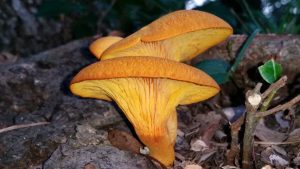

There are multiple jack o’lantern species, but this is the one that grows in Quebec. It is famous for glowing in the dark and resembling the golden chanterelle. Actually, the glow is faint at best, and the resemblance to the chanterelle is superficial, but foragers do sometimes make the mistake. Those who do wish they hadn’t. While not usually deadly, the toxin in the jack o’lantern has very unpleasant effects.
Panther Cap (Amanita pantherina)
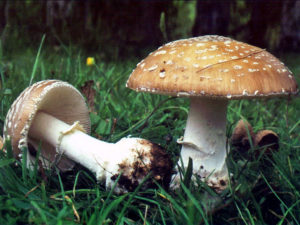

The Panther Cap is another Amanita, but it does not contain the same toxin as the Destroying Angel and is not usually deadly—it is poisonous, however. Because the toxin in question is psychoactive, causing hallucinations and an altered mind-state, people do sometimes eat it on purpose, though most cases involve mistaken identity or young children (or puppies) eating things randomly. But this does not sound like a fun high, as it is accompanied by gastrointestinal problems and seizures and often simply results in unconsciousness[xii]. Not a good trip.
Our Recommended Field Guides
COVER | TITLE | Header | ||
|---|---|---|---|---|
OUR #1 RATED | ||||
Magic Mushrooms
Psilocybin is illegal in Canada, although there are various exceptions made, and the law may be changing soon, at least in some provinces[xiii]. For the time being, though, while you are much less likely to be punished to psilocybin possession than you would be in the United States, that is largely to the result of unofficial policies not to enforce certain laws—there is nothing to stop these policies being reversed at any time, so caution is in order.
Caution is in order in general, since psilocybin is not a risk-free substance, and many psilocybin-containing mushrooms look very much like the aptly-named Deadly Galerina. These mushrooms are not toys.
They are tools.
Some of them grow wild in Quebec[xiv].
Gymnopilus sp.
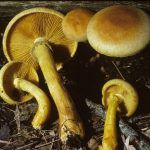

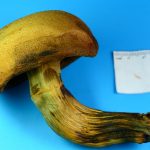

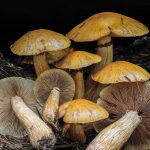

Members of the genus, Gymnopilus, are known as the Rustgills because of their rusty-colored spores. They are little, brownish mushrooms, usually of an orange or yellowish shade, and their current taxonomy bears little to no similarity to the genetic relationships of the group. They’re going to have to be re-defined and re-named, one of these days. The ones psychonauts are interested belong to a “species complex” (that is a technical term for “big taxonomic mess”) that is extra-fun to attempt sorting out. The two or three species in the complex thought to live in Quebec are called (according to current species definitions), G. luteus, G. speciosissimus, and G. viridans, but you might as well refer to all of them as laughing gyms.
These are psychoactive, yes, but they seem not to be very popular, as it is difficult to find published trip reports on exactly what their use feels like. It’s not clear why they are not better known, but perhaps it is just as well, because the best way to tell the difference between a Gym and the Deadly Galerina involves a rather high-end microscope[xv].
Pholiotina cyanopus


This is one of two psychoactive members of its genus, although it doesn’t seem to be very popular and is difficult to find and identify, because of its small size[xvi].
Panaeolus sp.
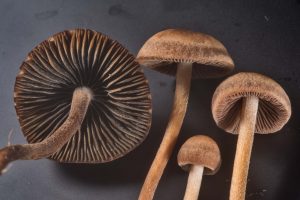

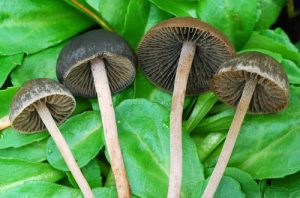

The Pans, or Mottlegills (so named because their dark spores develop in patches) are a variable lot from a psychonaut’s perspective, as members of the genus vary from not psychoactive at all to extremely potent. Some species are nearly as popular among users as Psilocybes, and can be cultivated. Quebec has at least two species, the Banded Mottlegill (P. cinctulus) and P. olivaceus, which has no common name in English, though “olive mottlegill” seems fitting. The former is extremely well-spread and of moderate potency. The latter is weakly psychoactive at best; some specimens are not active at all[xvii].
Psilocybe sp.


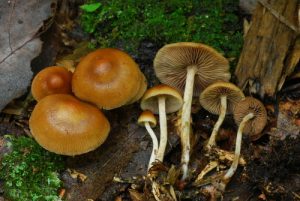



This genus, which appears not to have a common name as a group, is the best-known of the psychoactive mushrooms and includes Psilocybe cubensis, the most widely-cultivated “magic mushroom” in the world—but P. cubensis does not grow wild in Quebec, the climate being too cold.
Quebec has at least three species of Psilocybes. P. quebecensis, which may actually be a subspecies of the Mexican P. aztecorum, is one of the most northerly Psilocybes known. It is moderately-potent and pleasant-tasting, but cannot be cultivated as it will not fruit in artificial growing conditions[xviii]. The Little Blue-Foot (P. caerulipes) is usually moderately potent, but its psilocybin content can vary by an order of magnitude from one specimen to another. The popular Liberty Cap (Psilocybe semilanceata)[xix] is, surprisingly, not named for the effects of its high—rather, its cap supposedly resembles a certain style of hat historically associated with freedom. It is very potent, and retains its potency well in storage, but is very small.
Our Recommended Field Guides
COVER | TITLE | Header | ||
|---|---|---|---|---|
OUR #1 RATED | ||||
References:
[i] (2020). Mushroom’s Quest. Greentrail
[ii] (n.d.). Mushrooms of Quebec Province. Project Noah
[iii] (n.d.). Wild Edible Mushrooms of Quebec. Northern Bushcraft
[iv] Bergo, A. (2022). The Blue Chanterelle: Polyozwllus multiplex. Forager/Chef
[v] (n.d.). Suillus grevillei (Klotzsch) Singer—Large Bolete. First Nature
[vi] Kuo, M. (2013). Marasmius oreades. MushroomExpert
[vii] (n.d.). Marasmius oreades (Bolton) Fr.—Fairy Ring Champignon. First Nature
[viii] Bergo, A. (2022). Indigo Milk Cap Mushrooms. Forager/Chef
[ix] Volk, T. (1998). Tom Volk’s Fungus of the Month for November 1998. Tom’s Fungi
[x] Kuo, M. (2021). Clitocyboid Mushrooms. MushroomExpert
[xi] (n.d.). Paxillus involutus (Batsch) Pers.—Brown Rollrim. First Nature
[xii] (n.d.). Amanita pantherinoides. Vancouver Mycological Society
[xiii] (n.d.). Psilocybin. PsychedelicLaw.ca
[xiv] (n.d.). Which Psilocybin Mushrooms Grow Wild in My Area? Shroomery
[xv] Kuo, M. (2007). The Genus, Gymnopilus. MushroomExpert
[xvi] (n.d.). Pholiotina cyanopus (G.F. Atk.) Singer. Shroomery
[xvii] (n.d.). Panaeolus olivaceus. Philosophy
[xviii] Psillow (2019). Psilocybe quebecensis. Psillow
[xix] Barlow, C. (2022). Liberty Caps Are Among the Most Potent Magic Mushrooms. Double Blind

